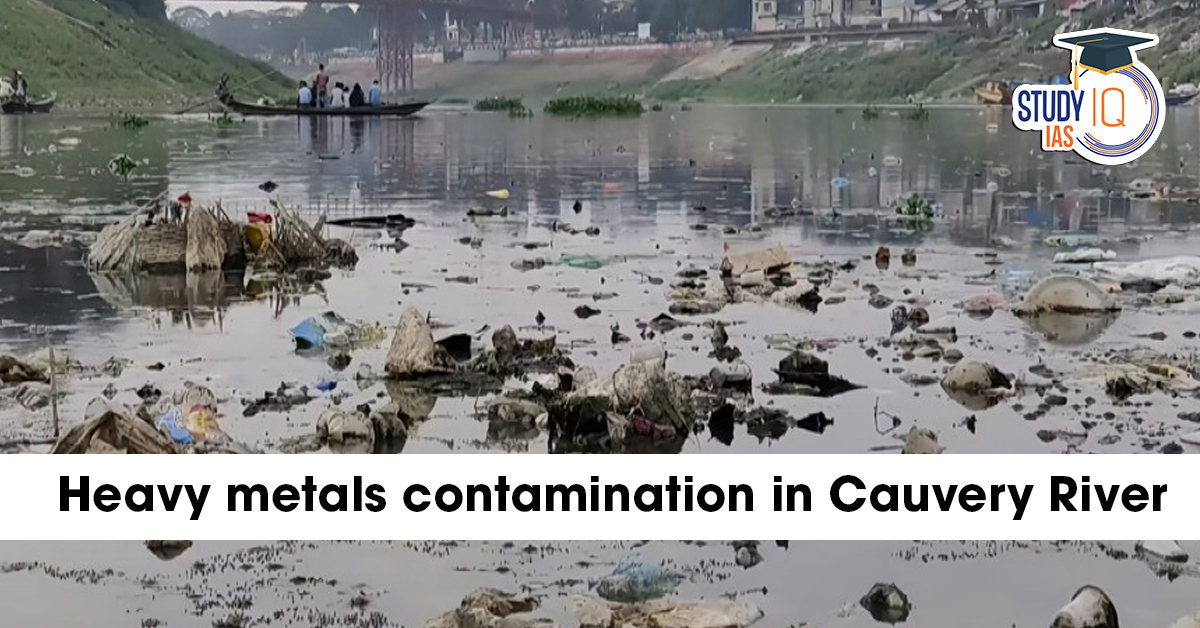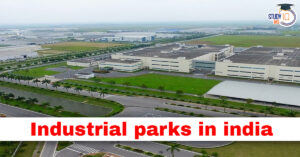Table of Contents
Recent research conducted by Tamil Nadu-based environmental scientists has revealed alarming levels of heavy metals such as lead (Pb), cadmium (Cd), mercury (Hg), and arsenic (As) in the Cauvery River and its fish species.
This contamination poses a serious risk to biodiversity, human health, and the livelihoods of communities depending on the river for water, agriculture, and fisheries.
About the Cauvery River
The Cauvery (Kaveri) River is one of South India’s most important water systems, flowing through Karnataka, Tamil Nadu, Kerala, and Puducherry.
It supports agriculture, drinking water supply, and hydropower generation — earning it the title of “Ganga of the South.”
However, rapid industrialization, urbanization, and agricultural runoff have led to severe pollution, threatening the river’s ecological balance.
What are Heavy Metals?
Heavy metals are metallic elements with high density and atomic weight that are toxic at low concentrations.
They are naturally found in the Earth’s crust but become dangerous when released into water, air, or soil through human activities.
Common Heavy Metals Found in the Cauvery River:
-
Lead (Pb) – from batteries, paints, and pipes
-
Cadmium (Cd) – from fertilizers and electronic waste
-
Mercury (Hg) – from industrial effluents
-
Arsenic (As) – from pesticides and mining waste
-
Chromium (Cr) – from tanneries and dye industries
Sources of Heavy Metal Contamination in the Cauvery River
-
Industrial Effluents:
Industries along the Cauvery basin — including textiles, electroplating, paper mills, and tanneries — discharge untreated wastewater into the river.
These effluents contain lead, chromium, and mercury, which settle in sediments and bioaccumulate in aquatic organisms. -
Agricultural Runoff:
Overuse of chemical fertilizers and pesticides releases cadmium and arsenic into the river through irrigation return flows. -
Domestic Sewage and Urban Waste:
Untreated sewage from cities like Erode, Tiruchirappalli, and Thanjavur adds not only organic waste but also trace metals from household products. -
E-waste and Solid Waste Disposal:
Improper dumping of electronic and plastic waste introduces lead, cadmium, and nickel into the water system. -
Mining and Soil Erosion:
Natural weathering and acidic runoff from nearby mining zones can leach heavy metals into the river water.
Impact on Aquatic Ecosystems
1. Bioaccumulation and Biomagnification
Heavy metals are non-biodegradable and tend to bioaccumulate in fish, plankton, and sediments.
Predatory fish and humans consuming these species experience biomagnification, where metal concentration increases with each trophic level.
2. Fish Health and Biodiversity
High levels of mercury and cadmium interfere with fish reproduction, growth, and gill function.
Researchers have reported deformed fish larvae, reduced diversity, and declining fish catch in parts of the Cauvery.
3. Soil and Agricultural Impact
Contaminated irrigation water affects soil quality and transfers heavy metals to crops, entering the human food chain.
Impact on Human Health
Communities living along the Cauvery River depend on it for drinking water, bathing, and fishing.
Long-term exposure to heavy metals can cause:
| Heavy Metal | Health Effects |
|---|---|
| Lead (Pb) | Affects brain development, especially in children |
| Mercury (Hg) | Damages kidneys and nervous system |
| Cadmium (Cd) | Causes bone and kidney disorders |
| Arsenic (As) | Leads to skin lesions, cardiovascular and cancer risks |
| Chromium (Cr VI) | Carcinogenic; affects lungs and liver |
Environmental Consequences
-
Loss of biodiversity: Decline in sensitive aquatic species
-
Eutrophication: Heavy metals interact with organic waste to accelerate algal blooms
-
Sediment toxicity: Metals settle at the bottom, creating long-term contamination zones
-
Altered food web: Toxic accumulation in fish affects birds and mammals that feed on them
Key Research Findings (2025 Study)
The 2025 Tamil Nadu study revealed:
-
Fish samples from the Erode and Tiruchirappalli sections of the river contained lead and mercury levels above WHO limits.
-
Water quality analysis showed high concentrations of cadmium and chromium due to untreated industrial discharge.
-
Sediment samples showed long-term accumulation of heavy metals, proving that pollution has been continuous for years.
Government Regulations and Initiatives
-
Central Pollution Control Board (CPCB) – Monitors water quality and effluent standards.
-
National River Conservation Plan (NRCP) – Focuses on reducing industrial and municipal discharge.
-
State Pollution Control Boards – Enforce effluent treatment requirements for industries along the Cauvery.
-
National Water Quality Monitoring Programme (NWQMP) – Tracks contamination levels in Indian rivers.
-
Minamata Convention on Mercury (2013) – India is a signatory; aims to reduce global mercury pollution.
Solutions and Way Forward
-
Effluent Treatment:
Mandatory installation and regular inspection of Effluent Treatment Plants (ETPs) in industries. -
Green Chemistry:
Promote non-toxic alternatives to heavy metal-based dyes, pesticides, and fertilizers. -
Public Awareness:
Educate local communities about the dangers of consuming contaminated fish or using untreated river water. -
Sediment Remediation:
Techniques like phytoremediation (using plants to absorb metals) and adsorbent filtration can help clean the river. -
Strengthened Monitoring:
Use of AI-based water sensors and satellite mapping to track metal contamination hotspots in real time.
Conclusion
The Cauvery River’s heavy metal contamination is not merely an environmental issue — it is a public health and economic crisis.
Unchecked industrial effluents and agricultural practices have led to the bioaccumulation of toxic metals in fish, water, and soil, endangering millions who depend on the river.
A collaborative approach involving government agencies, industries, farmers, and citizens is essential to restore the “Ganga of the South” to its pristine state.


 Industrial Parks in India: Driving Manuf...
Industrial Parks in India: Driving Manuf...
 National Maritime Heritage Complex (NMHC...
National Maritime Heritage Complex (NMHC...
 Reforming Fertiliser Subsidy in India: N...
Reforming Fertiliser Subsidy in India: N...

























